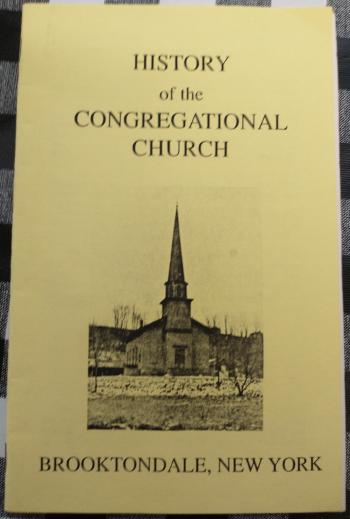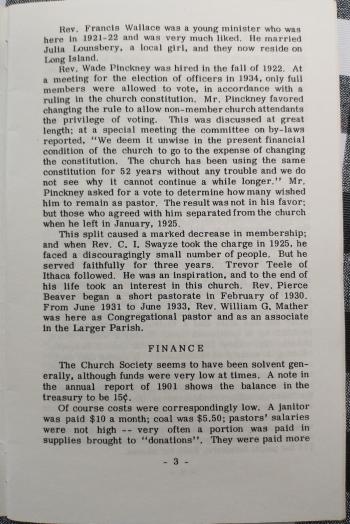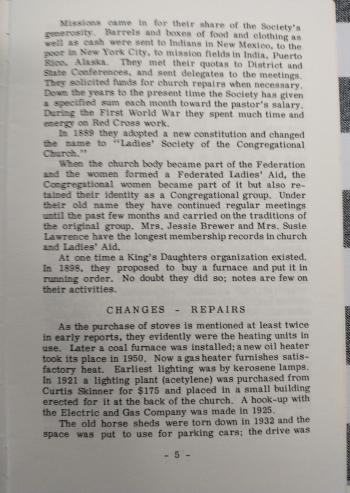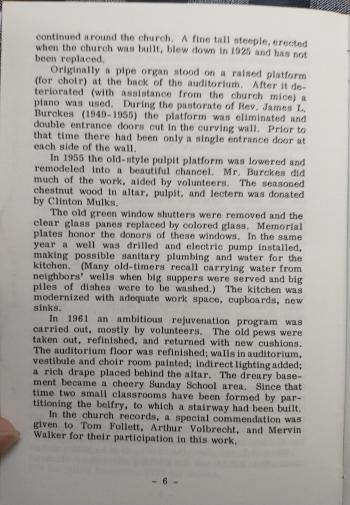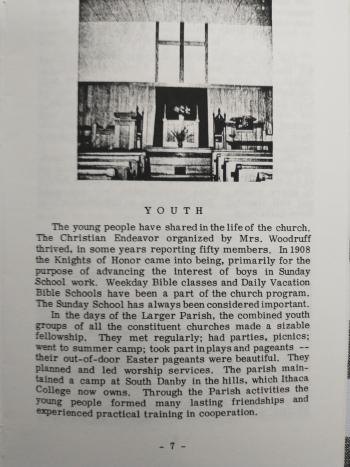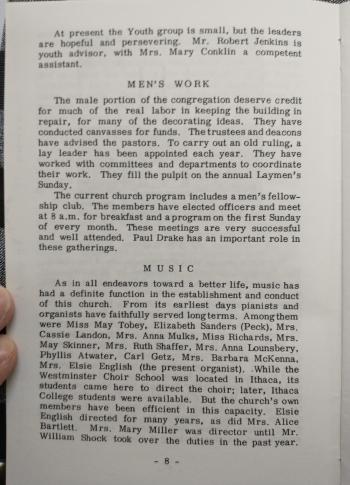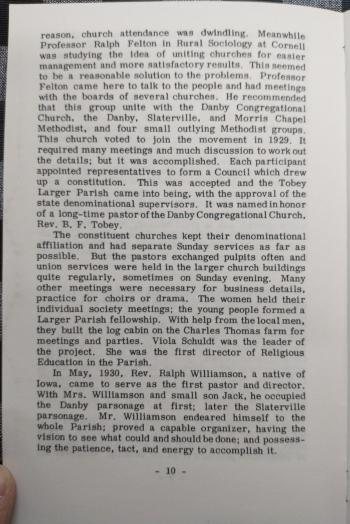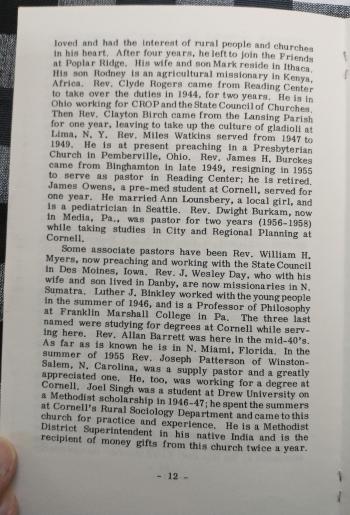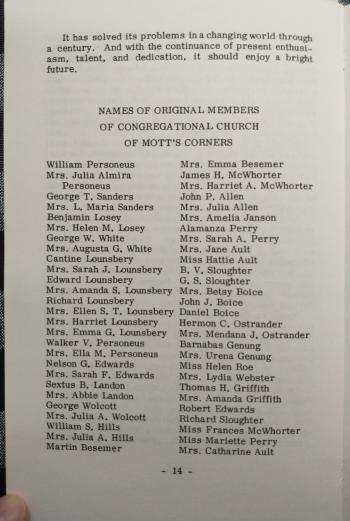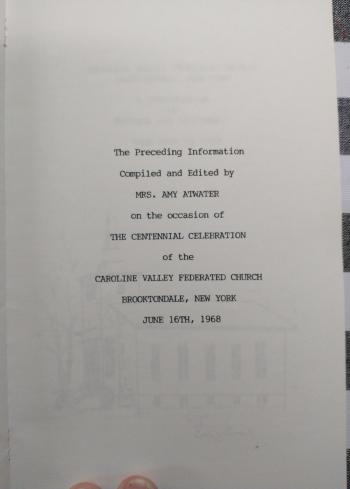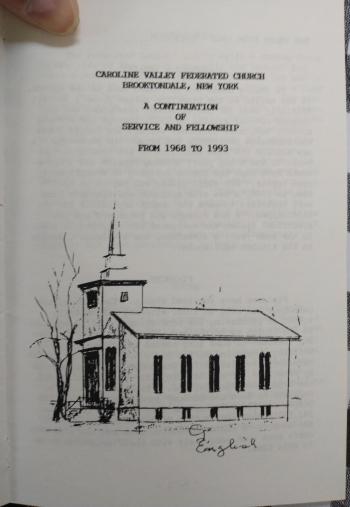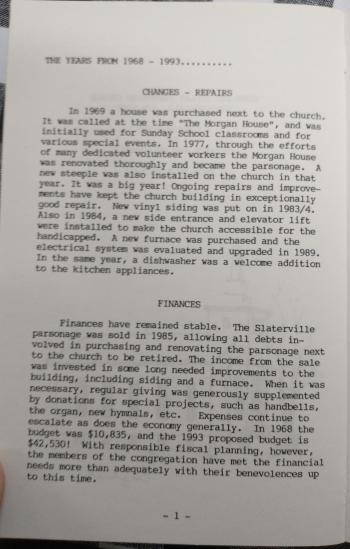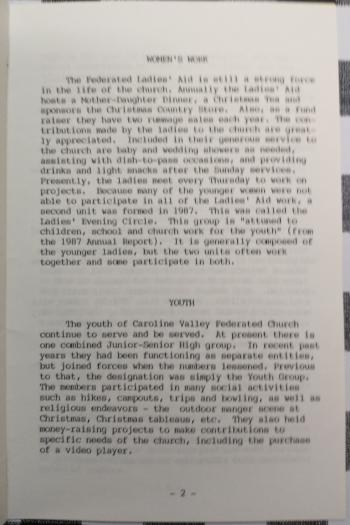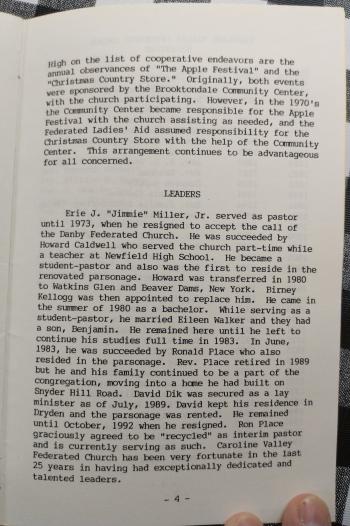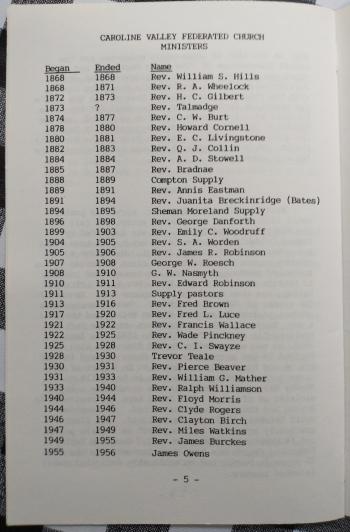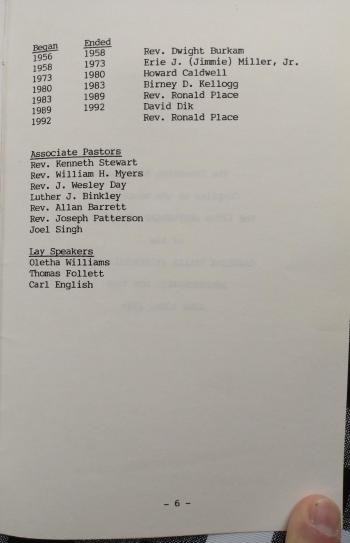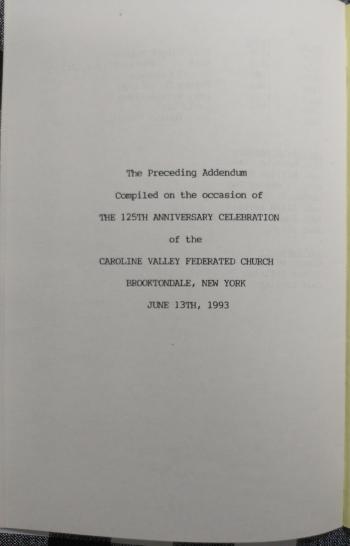History of the Congregational Church, Brooktondale, New York by Amy Atwater
Full text and images from History of the Congregational Church, Brooktondale, New York. Compiled and edited by Mrs. Amy Atwater on the occasion of The Centennial Celebration of the Caroline Valley Federated Church, Brooktondale, New York, June 16th, 1968. Used with permission from Caroline Valley Community Church.
“It started with a Methodist foundation, a Presbyterian church building; a congregation made up of Methodist and a Reformed group. And the whole, formed from these parts, was called Congregational.”

CONGREGATIONAL CHURCH OF MOTT’S CORNERS
(CAROLINE VALLEY FEDERATED CHURCH)
“The Congregational Church of Mott’s Corners, Tompkins County, in the State of New York, completed its organization on March 28, 1868.
“The original members, 55 in number, came from the Methodist E. Church, of Mott’s Corners, N. Y., and from the Reformed Church of America, in the town of Caroline, Tompkins Co., N. Y. When the following Brethren were chosen Deacons: William Personius, Benjamin Losey, George T. Saunders, and George W. White.
“Also the following Brethren were chosen Church Committee: Sextus B. Landon, Thomas H. Griffith, N. G. Edwards, Herman C. Ostrander, George Wolcott, and Cantine Lounsbery.
“When the Rev. William S. Hills, of Pottersville, Bradford County, Penn., was called to the work of Pastor and teacher in the church. (April 1st, 1868 — Dec. 1, 1868).
“The Society (Congregational) met March 28, 1868 and elected the following named persons trustees: Edward Lounsbery, Walker V. Personius, and John Wolcott. The certificate of incorporation was placed on file in the County Clerk’s office in Tompkins Co., N. Y., April 20, 1868.”
(The above is copied from a Manual, 100 copies of which were printed in 1868, containing church Discipline, Principles of church policy, Articles of Faith, Rule and By-laws, Profession of Religion. Names of charter members were also listed.)
The original foundation made in 1867, was intended for a Methodist Church. But when a decision was made to form a Congregational Society by combining members of the Mott’s Corners Methodist and the Reformed Church of Caroline, this foundation was put to use. The Presbyterian Church building of Varna was purchased for $400; the task of dismantling and moving this structure was accomplished by work bees. Land for the new church site had been purchased from George and Augusta White for $290, and Mr. White was employed to direct the construction work. The corner stone is in the northeast corner and a box below it contains a copy of a Discipline and other items of interest. (The Whites occupied the house now owned by Victor Borst.)
After the purchase of the land and frame and the completion of the building, there was a cost of $4256.55. The part of this debt remaining at the time of dedication ($3,300) was cancelled by pledges.
The new church was dedicated on February 18, 1869. Dr. Taylor of Binghamton gave the sermon; and Solomon’s Prayer at the dedication of the Temple (2 Chron:6) was read by Rev. Samuel Johnson, of Newark Valley.
At a Susquehanna Association meeting at Danby Congregational Church in 1868, the new church was “admitted to the fellowship and communion of the Association of Congregational Churches.”
The first Lord’s Supper was administered to the congregation on May 2, 1868, at the 10:30 a.m. service.
Before Rev. Hills took up his duties, a committee of three was appointed to solicit subscriptions for the pastor’s salary. No figures are given on this, but the pastor hired in 1872 was given a salary of $600, a donation, and a parsonage.
This church has been served by three women pastors. The first was Rev. Annis Ford Eastman. She was ordained here in 1889 and retained as pastor. Incidentally, she was the first woman to be ordained in a Congregational church. Her son, Max Eastman, is a well-known author. The second was Juanita Breckinridge (Bates), ordained here in 1892. She remained for two years, and during her lifetime as always ready to be of assistance. Rev. Emily C. Woodruff was here from 1899 to 1903. She organized the Christian Endeavor.
Rev. Francis Wallace was a young minister who was here in 1921-22 and was very much liked. He married Julia Lounsbery, a local girl, and they now reside on Long Island.
Rev. Wade Pinckney was hired in the fall of 1922. At a meeting for the election of officers in 193[2?]4, only full members were allowed to vote, in accordance with a ruling in the church constitution. Mr. Pinckney favored changing the rule to allow non-member church attendants the privilege of voting. This was discussed at great length; at a special meeting the committee on by-laws reported, “We deem it unwise in the present financial condition of the church to go to the expense of changing the constitution. The church has been using the same constitution for 52 years without any trouble and we do not see why it cannot continue a while longer.” Mr. Pinckney asked for a vote to determine how many wished him to remain as pastor. The result was not in his favor; but those who agreed with him separated from the church when he left in January, 1925.
This split caused a marked decrease in membership; and when Rev. C. I. Swayze took the charge in 1925, he faced a discouragingly small number of people. But he served faithfully for three years. Trevor Teele of Ithaca followed. He was an inspiration, and to the end of his life took an interest in this church. Rev. Pierce Beaver began a short pastorate in February of 1930. From June 1931 to June 1933, Rev. William G. Mather was here as Congregational pastor and as an associate in the Larger Parish.
FINANCE
The Church Society seems to have been solvent generally, although funds were very low at times. A note in the annual report of 1901 shows the balance in the treasury to be 15¢.
Of course costs were correspondingly low. A janitor was paid $10 a month; coal was $5.50; pastors’ salaries were not high – very often a portion was paid in supplies brought to “donations”. They were paid more if they found their own places to live. The house now owned by Martha Whitely was rented for a parsonage around the turn of the century. (Owned by a Phillips). In 1913 a charge of $1 for tuning piano was recorded; also 20¢ was paid to the Ithaca-Slaterville stage driver for delivering supplies: stove and pipe.
As has always been the custom here, much of the labor on church repairs and upkeep was done by volunteers. Although in 1913 the expense for painting the church and steps was $261.20, a goodly sum.
In 1921 the board applied to the New York State Conference for $400 missionary aid, which was available for worthy churches needing assistance.
WOMEN’S WORK
The efforts of the women have been a contributing factor to the success and continuity of this church. Interested women met on June 10, 1868 and organized the “Congregational Aid Society of Mott’s Corners.” Initiation fee was 25¢, dues 5¢ per week. The moderator was “accountable” for closing each meeting with prayer.
It was an industrious company. The members raised money by “sociables” of various kinds: chicken pie, maple sugar; by oyster suppers and strawberry festivals. They pieced and tied quilts for sale, made rag rugs, had bake sales, served cafeteria lunches and suppers, put on plays, sponsored concerts with home and outside talent. Their minutes state that a Victrola concert was given in 1915 by a gentleman from Hickey’s Music Store; tickets 10¢. They held fairs in the church basement offering a variety of merchandise. It seems they cooperated with the other church officers; one year, according to their minutes, the ladies had planned entertainment for Hallowe’en, but obligingly abandoned it when the church officers objected to the type of it. The minutes do not describe the type.
In spite of slight charges for their work, these active women managed to pay $300 on the original church debt. As early as 1869 they paid $129 for church carpet and $74 for pulpit furniture, $100 for stoves.
Missions came in for their share of the Society’s generosity. Barrels and boxes of food and clothing as well as cash were sent to Indians in New Mexico, to the poor in New York City, to mission fields in India, Puerto Rico, Alaska. They met their quotas to District and State Conferences, and sent delegates to the meetings. They solicited funds for church repairs when necessary. Down the years to the present time the Society has given a specified sum each month toward the pastor’s salary. During the First World War they spent much time and energy on Red Cross work.
In 1889 they adopted a new constitution and changed the name to “Ladies’ Society of the Congregational Church.”
When the church body became part of the Federation and the women formed a Federated Ladies’ Aid, the Congregational women became part of it but also retained their identity as a Congregational group. Under their old name they have continued regular meetings until the past few months and carried on the traditions of the original group. Mrs. Jessie Brewer and Mrs. Susie Lawrence have the longest membership records in church and Ladies’ Aid.
At one time, a King’s Daughters organization existed. In 1898, they proposed to buy a furnace and put it in running order. No doubt they do so; notes are few on their activities.
CHANGES — REPAIRS
As the purchase of stoves is mentioned at least twice in early reports, they evidently were the heating units in use. Later a coal furnace was installed; a new oil heater took its place in 1950. Now a gas heater furnishes satisfactory heat. Earliest lighting was by kerosene lamps. In 1921 a lighting plant (acetylene) was purchased from Curtis Skinner for $175 and placed in a small building erected for it at the back of the church. A hook-up with the Electric and Gas Company was made in 1925.
The old horse sheds were torn down in 1932 and the space was put to use for parking cars; the drive was continued around the church. A fine tall steeple, erected when the church was built, blew down in 1925 and has not been replaced.
Originally a pipe organ stood on a raised platform (for choir) at the back of the auditorium. After it deteriorated (with assistance from the church mice) a piano was used. During the pastorate of Rev. James L. Burckes (1949-1955) the platform was eliminated and double entrance doors cut in the curving wall. Prior to that time there had been only a single entrance door at each side of the wall.
In 1955 the old-style pulpit platform was lowered and remodeled into a beautiful chancel. Mr. Burckes did much of the work, aided by volunteers. The seasoned chestnut wood in altar, pulpit, and lectern was donated by Clinton Mulks.
The old green window shutters were removed and the clear glass panes replaced with colored glass. Memorial plates honor the donors of these windows. In the same year a well was drilled and electric pump installed, making possible sanitary plumbing and water for the kitchen. (Many old-timers recall carrying water from neighbors’ wells when big suppers were served and big piles of dishes were to be washed.) The kitchen was modernized with adequate work space, cupboards, new sinks.
In 1961 an ambitious rejuvenation program was carried out, mostly by volunteers. The old pews were taken out, refinished, and returned with new cushions. The auditorium floor was refinished; walls in auditorium, vestibule and choir room painted; indirect lighting added; a rich drape placed behind the altar. The dreary basement became a cheery Sunday School area. Since that time two small classrooms have been formed by partitioning the belfry, to which a stairway had been built.
In the church records, a special commendation was given to Tom Follett, Arthur Volbrecht, and Mervin Walker for their participation in this work.
YOUTH
[Photograph of altar.]
The young people have shared in the life of the church. The Christian Endeavor organized by Mrs. Woodruff thrived, in some years reporting fifty members. In 1908, the Knights of Honor came into being, primarily for the purpose of advancing the interest of boys in Sunday School work. Weekday Bible classes and Daily Vacation Bible Schools have been a part of the church program. The Sunday School has always been considered important.
In the days of the Larger Parish, the combined youth groups of all the constituent churches made a sizable fellowship. They met regularly; had parties, picnics; went to summer camp; took part in plays and pageants – their out-of-door Easter pageants were beautiful. They planned and led worship services. The parish maintained a camp at South Danby in the hills, which Ithaca College now owns. Through the Parish activities the young people formed many lasting friendships and experienced practical training in cooperation.
At present the Youth group is small, but the leaders are hopeful and persevering. Mr. Robert Jenkins is youth advisor, with Mrs. Mary Conklin a competent assistant.
MEN’S WORK
The male portion of the congregation deserve credit for much of the real labor in keeping the building in repair, for many of the decorating ideas. They have conducted canvasses for funds. The trustees and deacons have advised the pastors. To carry out an old ruling, a lay leader has been appointed each year. They have worked with committees and departments to coordinate their work. They fill the pulpit on the annual Laymen’s Sunday.
The current church program includes a men’s fellowship club. The members have elected officers and meet at 8 a.m. for breakfast and a program on the first Sunday of every month. These meetings are very successful and well attended. Paul Drake has an important role in these gatherings.
MUSIC
As in all endeavors toward a better life, music has had a definite function in the establishment and conduct of this church. From its earliest days pianists and organists have faithfully served long terms. Among them were Miss May Tobey, Elizabeth Sanders (Peck), Mrs. Cassie Landon, Mrs. Anna Mulks, Miss Richards, Mrs. May Skinner, Mrs. Ruth Shaffer, Mrs. Anna Lounsbery, Phyllis Atwater, Carl Getz, Mrs. Barbara McKenna, Mrs. Elsie English (the present organist). While the Westminster Choir School was located in Ithaca, its students came here to direct the choir; later, Ithaca College students were available. But the church’s own members have been efficient in this capacity. Elsie English directed for many years, as did Mrs. Alice Bartlett. Mrs. Mary Miller was director until Mr. William Shock took over the duties in the past year.
Mrs. Barbara McKenna directs a Junior and a Chancel Choir. Mrs. Bartlett organized the Bell Choir and directed it; Elsie English is directing it at the present time. A Baldwin organ has replaced the older instruments; the chimes recently added are a memorial to Mrs. Maureen Fuller.
Early church records reveal that music was an important part of the worship. Concerts were given; often by home talent, sometimes by students of the Ithaca Conservatory (the present Ithaca College). Singing was included in meetings and church service. Excellent musical and dramatic programs have consistently been a characteristic of this congregation.
While the Parish was alive and active the several congregations joined to produced plays and pageants, concerts, and special worship programs. A dramatic society already formed in Morris Chapel, continued as a Parish project under the guidance of Agnes Giles. A men’s quartet was in great demand. A federated choir, made up of singers from the three communities, had an active part in the Federated Church from the start; and is still an important addition to the services.
COOPERATION
The Congregational Church has ever been cooperative. Since its beginning it has given the use of its basement to Boy Scouts, Home Bureau, Red Cross, G.A.R., Grangers, Old Home Day gatherings. It entertained the District Association several times. After the Baptists lost their sheds by fire, they were offered the use of the Congregational sheds. For a number of years the two churches held union services on Memorial Day and at Christmas. Encouraged by this, the Congregationalists several times invited the sister church to unite permanently. The Baptists were not ready for such a move, and the idea died.
With changing times, the country church ceased to be the focal point of the community. With the advent of cars more and more people went into town to bigger churches or substituted pleasure trips for worship. Whatever the reason, church attendance was dwindling. Meanwhile Professor Ralph Felton in Rural Sociology at Cornell was studying the idea of uniting churches for easier management and more satisfactory results. This seemed to be a reasonable solution to the problems. Professor Felton came here to talk to the people and had meetings with the boards of several churches. He recommended that this group unite with the Danby Congregational Church, the Danby, Slaterville, and Morris Chapel Methodist, and four small outlying Methodist groups. This church voted to join the movement in 1929. It required many meetings and much discussion to work out the details; but it was accomplished. Each participant appointed representatives to form a Council which drew up a constitution. This was accepted and the Tobey Larger Parish came into being, with the approval of the state denominational supervisors. It was named in honor of a long-time pastor of the Danby Congregational Church, Rev. B. F. Tobey.
The constituent churches kept their denominational affiliation and had separate Sunday services as far as possible. But the pastors exchanged pulpits often and union services were held in the larger church buildings quite regularly, sometimes on Sunday evening. Many other meetings were necessary for business details, practice for choirs or drama. The women held their individual society meetings; the young people formed a Larger Parish fellowship. With help from the local men, they built the log cabin on the Charles Thomas farm for meetings and parties. Viola Schuldt was the leader of the project. She was the first director of Religious Education in the Parish.
In May, 1930, Rev. Ralph Williamson, a native of Iowa, came to serve as the first pastor and director. With Mrs. Williamson and small son Jack, he occupied the Danby parsonage at first; later the Slaterville parsonage. Mr. Williamson endeared himself to the whole Parish; proved a capable organizer, having the vision to see what could and should be done; and possessing the patience, tact, and energy to accomplish it.
More and more the three congregations on this side of the hill drew together to ease the pastor’s duties, to enjoy the larger fellowship. For a few years services alternated between Slaterville and Brooktondale; Crispell buses furnished transportation. In 1935 a federation was formed for three years. In October, 1938, this federation was made permanent by a vote of the members and a constitution was drawn up. It was a difficult decision to make for some of the older members who had grown up in their home churches; however, the Morris Chapel and Slaterville people yielded graciously and agreed to use the Brooktondale Church, as it was centrally located.
Later the Slaterville building became a community hall, and has burned since then. The Morris Chapel church, after being put to use for plays and social meetings, was abandoned because of need of major repairs. It and its site were sold and the money realized was donated toward the purchase price of the Baldwin organ in 1955. The Slaterville parsonage has been occupied by several ministers of the Parish and Federation; and when not so occupied has been rented, adding to church income.
The Danby Congregational Congregation withdrew from the Larger Parish around 1947. The Methodist Church there continued independently until it joined the Congregationalists in a trial federation in 1954; this became permanent in 1957. The smaller groups of the Larger Parish operated independently or were absorbed by larger ones. Thus the Larger Parish was dissolved, leaving a Federation on either side of the hill; but during its operation it was a boon to rural communities.
The Rural Church Institute and Cornell’s Department of Rural Sociology were of great assistance to the Parish and the constituent churches; as were the state supervisors, among them Rev. James A. G. Moore, Congregational State Superintendent, who now resides in the Ithaca area.
Mr. Williamson resigned after nine years to take charge of the Rural Life Institute at Cornell. He was succeeded by the late Rev. Floyd Morris. He was dearly loved and had the interest of rural people and churches in his heart. After four years, he left to join the Friends at Poplar Ridge. His wife and son Mark reside in Ithaca. His son Rodney is an agricultural missionary in Kenya, Africa. Rev. Clyde Rogers came from Reading Center to take over the duties in 1944, for two years. He is in Ohio working for CROP and the State Council of Churches. Then Rev. Clayton Birch came from the Lansing Parish for one year, leaving to take up the culture of gladioli at Lima, N. Y. Rev. Miles Watkins served from 1947 to 1949. He is at present preaching in a Presbyterian Church in Pemberville, Ohio. Rev. James H. Burckes came from Binghamton in late 1949, resigning in 1955 to serve as pastor in Reading Center; he is retired. James Owens, a pre-med student at Cornell, served for one year. He married Ann Lounsbery, a local girl, and is a pediatrician in Seattle. Rev. Dwight Burkam, now in Media, Pa., was pastor for two years. (1956-1958) while taking studies in City and Regional Planning at Cornell.
Some associate pastors have been Rev. William H. Myers, now preaching and working with the State Council in Des Moines, Iowa. Rev. J. Wesley Day, who with his wife and son lived in Danby, are now missionaries in N. Sumatra. Luther J. Binkley worked with the young people in the summer of 1946, and is a Professor of Philosophy at Franklin Marshall College in Pa. The three last named were studying for degrees at Cornell while serving here. Rev. Allan Barrett was here in the mid-40’s. As far as is known he is in N. Miami, Florida. In the summer of 1955 Rev. Joseph Patterson of Winston-Salem, N. Carolina, was a supply pastor and a greatly appreciated one. He, too, was working for a degree at Cornell. Joel Singh was a student at Drew University on a Methodist scholarship in 1946-47; he spent the summers at Cornell’s Rural Sociology Department and came to this church for practice and experience. He is a Methodist District Superintendent in his native India and is the recipient of money gifts from this church twice a year.
There have been some wonderful Directors of Religious Education. Viola Schuldt, the first in that position, married Gardiner Winn and they were missionaries in China. Lucille Brotherton married Larry Pickard and they have been working with the Indians in Oklahoma for a number of years. Christine Burdick was here until 1936, when she was married to Rev. Orville Bosley, Presbyterian pastor in Delhi, N. Y. Then Mrs. Rachel Myers took over the work while her husband was an associate pastor in the Parish.
In 1958 E. J. Miller, wrestling coach at Cornell, was secured as lay minister; and he has remained. He was immediately liked and has grown close to the people. He has a vital personality, and in spite of heaving coaching duties gives his time and energy unstintingly to the work of the church. He is assisted at times by Rev. Kenneth Stewart and by Tom Follett, lay member.
An influx of new families has brought fresh life and interest to the church. An active council discusses and formulates plans and policies. The Sunday School is well staffed with classes for all ages. The choirs are efficiently directed. The Federated Women’s Society has monthly meetings with a good attendance; has a Christmas tea, supervises the Mother-Daughter banquet; serves dinners or lunches on occasions such as this centennial; devises means of raising funds.
The Caroline Valley Federated Church fosters the cooperation practiced in the Parish; also maintains the policy adopted by the newly organized Congregational Church in 1868; to promote the kingdom of Christ; to provide Christian service at home and abroad.
The Congregational Church is proud to have survived and served through the past one hundred years; and to enjoy the fellowship of the Methodists within the present Federation. Perhaps it was fated from the beginning to become federated. It started with a Methodist foundation, a Presbyterian church building; a congregation made up of Methodist and a Reformed group. And the whole, formed from these parts, was called Congregational.
It has solved its problems in a changing world through a century. And with the continuance of present enthusiasm, talent and dedication, it should enjoy a bright future.
NAMES OF ORIGINAL MEMBERS OF CONGREGATIONAL CHURCH OF MOTT’S CORNERS
William Personeus
Mrs. Julia Almira Personeus
George T. Sanders
Mrs. L. Maria Sanders
Benjamin Losey
Mrs. Hellen M. Losey
George W. White
Mrs. Augusta G. White
Cantine Lounsbery
Mrs. Sarah J. Lounsbery
Edward Lounsbery
Mrs. Amanda S. Lounsbery
Richard Lounsbery
Mrs. Ellen S. T. Lounsbery
Mrs. Harriet Lounsbery
Mrs. Emma G. Lounsbery
Walker V. Personeus
Mrs. Ella M. Personeus
Nelson G. Edwards
Mrs. Sarah F. Edwards
Sextus B. Landon
Mrs. Abbie Landon
George Wolcott
Mrs. Julia A. Wolcott
William S. Hills
Mrs. Julia A. Hills
Martin Besemer
Mrs. Emma Besemer
James H. McWhorter
Mrs. Harriet A. McWhorter
John P. Allen
Mrs. Julia Allen
Mrs. Amelia Janson
Alamanza Perry
Mrs. Sarah A. Perry
Mrs. Jane Ault
Miss Hattie Ault
B. V. Sloughter
G. S. Sloughter
Mrs. Betsy Boice
John J. Boice
Daniel Boice
Hermon C. Ostrander
Mrs. Mendana J. Ostrander
Barnabas Genung
Mrs. Urena Genung
Miss Helen Roe
Mrs. Lydia Webster
Thomas H. Griffith
Mrs. Amanda Griffith
Robert Edwards
Richard Sloughter
Miss Frances McWhorter
Miss Mariette Perry
Mrs. Catharine Ault
The Preceding Information Compiled and Edited by MRS. AMY ATWATER on the occasion of THE CENTENNIAL CELEBRATION of the CAROLINE VALLEY FEDERATED CHURCH BROOKTONDALE, NEW YORK June 16TH, 1968
CAROLINE VALLEY FEDERATED CHURCH BROOKTONDALE, NEW YORK
A CONTINUATION OF SERVICE AND FELLOWSHIP FROM 1968 TO 1993
[Drawing of Congregational Church by Carl English.]
THE YEARS FROM 1968 — 1993……….
CHANGES—REPAIRS
In 1969 a house was purchased next to the church. It was called at the time, “The Morgan House”, and was initially used for Sunday School classrooms and for various special events. In 1977, through the efforts of many dedicated volunteer workers the Morgan House was renovated thoroughly and became the parsonage. A new steeple was also installed on the church in that year. It was a big year! Ongoing repairs and improvements have kept the church building in exceptionally good repair. New vinyl siding was put on in 1983/4. Also in 1984, a new side entrance and elevator lift were installed to make the church accessible for the handicapped. A new furnace was purchased and the electrical system was evaluated and upgraded in 1989. In the same year, a dishwasher was a welcome addition to the kitchen appliances.
FINANCES
Finances have remained stable. The Slaterville parsonage was sold in 1985, allowing all debts involved in purchasing and renovating the parsonage next to the church to be retired. The income from the sale was invested in some long needed improvements to the building, including siding and a furnace. When it was necessary, regular giving was generously supplemented by donations for special projects, such as handbells, the organ, new hymnals, etc. Expenses continue to escalate as does the economy generally. In 1968 the budget was $10,835, and the 1993 proposed budget is $42,530! With responsible fiscal planning, however, the members of the congregation have met the financial needs more than adequately with their benevolences up to this time.
WOMEN’S WORK
The Federated Ladies’ Aid is still a strong force in the life of the church. Annually the Ladies’ Aid hosts a Mother-Daughter Dinner, a Christmas Tea and sponsors the Christmas Country Store. Also, as a fund raiser they have two rummage sales each year. The contributions made by the ladies to the church are greatly appreciated. Included in their generous service in the church are baby and wedding showers as needed, assisting with dish-to-pass occasions, and providing drinks and light snacks after the Sunday services. Presently, the ladies meet every Thursday to work on projects. Because many of the younger women were not able to participate in all of the Ladies’ Aid work, a second unit was formed in 1987. This was called the Ladies’ Evening Circle. This group is “attuned to children, school and church work for the youth” (from the 1987 Annual Report). It is generally composed of the younger ladies, but the two units often work together and some participate in both.
YOUTH
The youth of Caroline Valley Federated Church continue to serve and be served. At present there is one combined Junior-Senior High group. In recent past years they have been functioning as separate entities, but joined forced when the numbers lessened. Previous to that, the designation was simply the Youth Group. The members participated in many social activities such as hikes, campouts, trips and bowling, as well as religious endeavors - the outdoor manger scene at Christmas, Christmas tableaus, etc. They also held money-raising projects to make contributions to specific needs of the church, including the purchase of a video player.
MEN’S WORK
The men of the congregation contribute immeasurably to the upkeep of the church. In the past this work was done via “work bees” on Saturdays. However, currently, as many men have retired, much of the work is done on Thursdays while the women do their thing. A dish-to-pass lunch is the reward for many hours of labor for both sexes. Unfortunately, the “Men’s Breakfast” has been discontinued, possibly due to the pace of today’s living. Perhaps in the future, time will be set aside for this unique event and it will be reborn.
MUSIC
This church is blessed with exceptionally devoted and talented members who have been very generous in sharing their musical talents. Elsie English was organist until her resignation in 1979. Susan Menzies Gibbons briefly served until October, 1980. Lorrane LaDue then became the organist and remains in that position. Bill Schoch led the adult choir until his retirement in 1989. At that time, Shirley Hilker took over this duty and is currently leading the choir very ably. Linda (Schoch) Crispell assists at the piano. A senior and junior bell choir are also an important addition to the musical ministry, as is the junior choir. Shirley Hilker, Linda Crispell and Lorraine LaDue are currently guiding these groups. A new Baldwin organ was purchased in 1980 and new bells have also been added.
COOPERATION
The Caroline Valley Federated Church finds many opportunities for cooperation at the denominational levels and also within the Brooktondale community.
High on the list of cooperative endeavors are the annual observances of “The Apple Festival” and the “Christmas Country Store.” Originally, both events were sponsored by the Brooktondale Community Center, with the church participating. However, in the 1970’s the Community Center became responsible for the Apple Festival with the church assisting as needed, and the Federated Ladies’ Aid assumed responsibility for the Christmas Country Store with the help of the Community Center. This arrangement continues to be advantageous for all concerned.
LEADERS
Erie J. “Jimmie” Miller Jr. served as pastor until 1973, when he resigned to accept the call of the Danby Federated Church. He was succeeded by Howard Caldwell who served the church part-time while a teacher at Newfield High School. He became a student-pastor and also was the first to reside in the renovated parsonage. Howard was transferred in 1980 to Watkins Glen and Beaver Dams, New York. Birney Kellogg was then appointed to replace him. He came in the summer of 1980 as a bachelor. While serving as a student-pastor, he married Eileen Walker and they had a son, Benjamin. He remained here until he left to continue his studies full time in 1983. In June, 1983, he was succeeded by Ronald Place who also resided in the parsonage. Rev. Place retired in 1989 but he and his family continued to be a part of the congregation, moving into a home he had built on Snyder Hill Road. David Dik was secured as a lay minister as of July, 1989. David kept his residence in Dryden and the parsonage was rented. He remained until October, 1992 when he resigned. Ron Place graciously agreed to be “recycled” as interim pastor and is currently serving as such. Caroline Valley Federated Church has been very fortunate in the last 25 years in having had exceptionally dedicated and talented leaders.
CAROLINE VALLEY FEDERATED CHURCH MINISTERS
| Began | Ended | Name |
|---|---|---|
| 1868 | 1868 | Rev. William S. Hills |
| 1868 | 1871 | Rev. R. A. Wheelock |
| 1872 | 1873 | Rev. H. C. Gilbert |
| 1873 | ? | Rev. Talmadge |
| 1874 | 1877 | Rev. C. W. Burt |
| 1878 | 1880 | Rev. Howard Cornell |
| 1880 | 1881 | Rev. E. C. Livingstone |
| 1882 | 1883 | Rev. Q. J. Collin |
| 1884 | 1884 | Rev. A. D. Stowell |
| 1885 | 1887 | Rev. Bradnae |
| 1888 | 1889 | Compton Supply |
| 1889 | 1891 | Rev. Annis Eastman |
| 1891 | 1894 | Rev. Juanita Breckinridge (Bates) |
| 1894 | 1895 | Sheman Moreland Supply |
| 1896 | 1898 | Rev. George Danforth |
| 1899 | 1903 | Rev. Emily C. Woodruff |
| 1904 | 1905 | Rev. S. A. Worden |
| 1905 | 1906 | Rev. James R. Robinson |
| 1907 | 1908 | George W. Roesch |
| 1908 | 1910 | G. W. Nasmyth |
| 1910 | 1911 | Rev. Edward Robinson |
| 1911 | 1913 | Supply pastors |
| 1913 | 1916 | Rev. Fred Brown |
| 1917 | 1920 | Rev. Fred L. Luce |
| 1921 | 1922 | Rev. Francis Wallace |
| 1922 | 1925 | Rev. Wade Pinckney |
| 1925 | 1928 | Rev. C. I. Swayze |
| 1928 | 1930 | Trevor Teale |
| 1930 | 1931 | Rev. Pierce Beaver |
| 1931 | 1933 | Rev. William G. Mather |
| 1933 | 1940 | Rev. Ralph Williamson |
| 1940 | 1944 | Rev. Floyd Morris |
| 1944 | 1946 | Rev. Clyde Rogers |
| 1946 | 1947 | Rev. Clayton Birch |
| 1947 | 1949 | Rev. Miles Watkins |
| 1949 | 1955 | Rev. James Burckes |
| 1955 | 1956 | James Owens |
| 1956 | 1958 | Rev. Dwight Burkam |
| 1958 | 1973 | Erie J. (Jimmie) Miller, Jr. |
| 1973 | 1980 | Howard Caldwell |
| 1980 | 1983 | Birney D. Kellogg |
| 1983 | 1989 | Rev. Ronald Place |
| 1989 | 1992 | Donald Dik |
| 1992 | Rev. Ronald Place |
Associate Pastors
Rev. Kenneth Stewart
Rev. William H. Myers
Rev. J. Wesley Day
Luther J. Binkley
Rev. Allan Barrett
Rev. Joseph Patterson
Joel Singh
Lay Speakers
Oletha Williams
Thomas Follett
Carl English
The Preceding Addendum Compiled on the occasion of THE 125TH ANNIVERSARY CELEBRATION of the CAROLINE VALLEY FEDERATED CHURCH BROOKTONDALE, NEW YORK JUNE 13TH, 1993
Errata
The pastor from 1885 to 1887 is Reverend Isaac R. Bradnack (1813 to 1897).
“George T. Saunders” is George Townley Sanders (14 Nov 1818 to 04 May 1887), Amanda (Sanders) Lounsbery’s father.
- The first Lord’s Supper is documented in church records occurring at Sunday services 03 May 1868, and not on Saturday 02 May 1868.
Source
The following digital photographs were taken at Caroline Valley Community Church, Fall 2021, and used for the transcription above.
